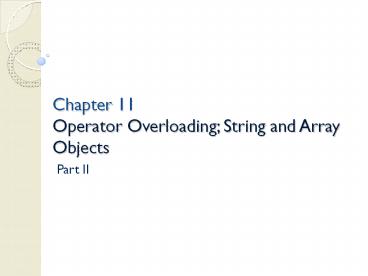Chapter 11 Operator Overloading; String and Array Objects - PowerPoint PPT Presentation
1 / 18
Title:
Chapter 11 Operator Overloading; String and Array Objects
Description:
Outputting/inputting entire arrays with and Array comparisons with == and != 3 ... Use overloaded operator to output. Use overloaded != operator to ... – PowerPoint PPT presentation
Number of Views:40
Avg rating:3.0/5.0
Title: Chapter 11 Operator Overloading; String and Array Objects
1
Chapter 11 Operator Overloading String and
Array Objects
- Part II
2
11.8 Case Study Array Class
- Pointer-based arrays in C
- No range checking
- Cannot be compared meaningfully with
- No array assignment (array names are const
pointers) - If array passed to a function, size must be
passed as a separate argument - Example Implement an Array class with
- Range checking
- Array assignment
- Arrays that know their own size
- Outputting/inputting entire arrays with ltlt and gtgt
- Array comparisons with and !
3
11.8 Case Study Array Class (Cont.)
- Copy constructor
- Used whenever copy of object is needed
- Passing by value (return value or parameter)
- Initializing an object with a copy of another of
same type - Array newArray( oldArray ) orArray newArray
oldArray (both are identical) - newArray is a copy of oldArray
- Prototype for class Array
- Array( const Array )
- Must take reference
- Otherwise, the argument will be passed by value
- Which tries to make copy by calling copy
constructor - Infinite loop
4
Array.h (1 of 2)
Most operators overloaded as member functions
(except ltlt and gtgt, which must be global functions)
Prototype for copy constructor
! operator simply returns opposite of
operator only need to define the operator
5
Array.h (2 of 2)
Operators for accessing specific elements of
Array object
6
Array.cpp (1 of 6)
7
Array.cpp (2 of 6)
We must declare a new integer array so the
objects do not point to the same memory
8
Array.cpp (3 of 6)
Want to avoid self assignment
This would be dangerous if this is the same
Array as right
9
Array.cpp (4 of 6)
integers1 5 calls integers1.operator( 5 )
10
Array.cpp (5 of 6)
11
Array.cpp (6 of 6)
12
fig11_08.cpp
Retrieve number of elements in Array
Use overloaded gtgt operator to input
13
Use overloaded ltlt operator to output
Use overloaded ! operator to test for inequality
Use copy constructor
Use overloaded operator to assign
14
Use overloaded operator to test for equality
Use overloaded operator to access individual
integers, with range-checking
15
(No Transcript)
16
(No Transcript)
17
Software Engineering Observation 11.4
- Copy constructor
- A constructor that is invoked when you construct
an object from a existed object. - Example
- Array integers2 integers1
- Array integers2(integers1)
- The argument to a copy constructor should be a
const reference to allow a const object to be
copied.
18
Common Programming Error 11.6
- Note that a copy constructor must receive its
argument by reference, not by value. Otherwise,
the copy constructor call results in infinite
recursion. - Because receiving an object by value requires the
copy constructor to make a copy of the argument
object. - Any time a copy of an object is required, the
classs copy constructor is called. - If the copy constructor received its argument by
value, the copy constructor would call itself
recursively to make a copy of its argument! - Array(const Array s)
Pass-by-value. The parameter is copied from its
argument by invoking copy constructor

